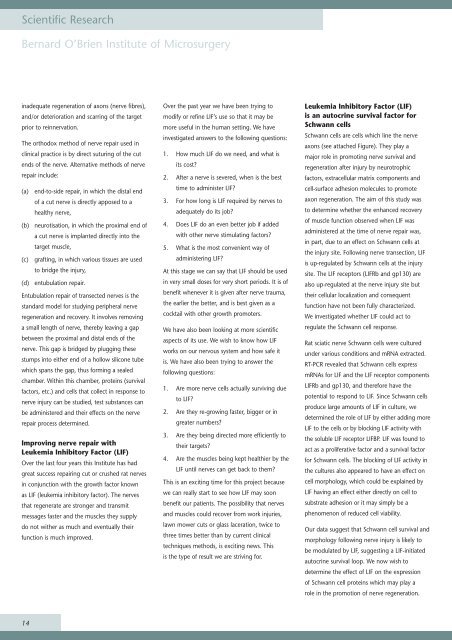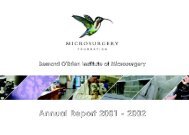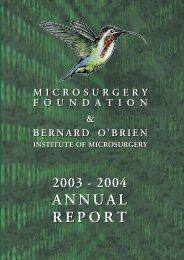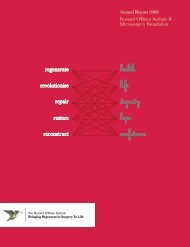2990 Microsurgery.qxd - O'Brien Institute
2990 Microsurgery.qxd - O'Brien Institute
2990 Microsurgery.qxd - O'Brien Institute
You also want an ePaper? Increase the reach of your titles
YUMPU automatically turns print PDFs into web optimized ePapers that Google loves.
Scientific Research<br />
Bernard O’Brien <strong>Institute</strong> of <strong>Microsurgery</strong><br />
inadequate regeneration of axons (nerve fibres),<br />
and/or deterioration and scarring of the target<br />
prior to reinnervation.<br />
The orthodox method of nerve repair used in<br />
clinical practice is by direct suturing of the cut<br />
ends of the nerve. Alternative methods of nerve<br />
repair include:<br />
(a)<br />
(b)<br />
(c)<br />
(d)<br />
end-to-side repair, in which the distal end<br />
of a cut nerve is directly apposed to a<br />
healthy nerve,<br />
neurotisation, in which the proximal end of<br />
a cut nerve is implanted directly into the<br />
target muscle,<br />
grafting, in which various tissues are used<br />
to bridge the injury,<br />
entubulation repair.<br />
Entubulation repair of transected nerves is the<br />
standard model for studying peripheral nerve<br />
regeneration and recovery. It involves removing<br />
a small length of nerve, thereby leaving a gap<br />
between the proximal and distal ends of the<br />
nerve. This gap is bridged by plugging these<br />
stumps into either end of a hollow silicone tube<br />
which spans the gap, thus forming a sealed<br />
chamber. Within this chamber, proteins (survival<br />
factors, etc.) and cells that collect in response to<br />
nerve injury can be studied, test substances can<br />
be administered and their effects on the nerve<br />
repair process determined.<br />
Improving nerve repair with<br />
Leukemia Inhibitory Factor (LIF)<br />
Over the last four years this <strong>Institute</strong> has had<br />
great success repairing cut or crushed rat nerves<br />
in conjunction with the growth factor known<br />
as LIF (leukemia inhibitory factor). The nerves<br />
that regenerate are stronger and transmit<br />
messages faster and the muscles they supply<br />
do not wither as much and eventually their<br />
function is much improved.<br />
Over the past year we have been trying to<br />
modify or refine LIF’s use so that it may be<br />
more useful in the human setting. We have<br />
investigated answers to the following questions:<br />
1. How much LIF do we need, and what is<br />
its cost?<br />
2. After a nerve is severed, when is the best<br />
time to administer LIF?<br />
3. For how long is LIF required by nerves to<br />
adequately do its job?<br />
4. Does LIF do an even better job if added<br />
with other nerve stimulating factors?<br />
5. What is the most convenient way of<br />
administering LIF?<br />
At this stage we can say that LIF should be used<br />
in very small doses for very short periods. It is of<br />
benefit whenever it is given after nerve trauma,<br />
the earlier the better, and is best given as a<br />
cocktail with other growth promoters.<br />
We have also been looking at more scientific<br />
aspects of its use. We wish to know how LIF<br />
works on our nervous system and how safe it<br />
is. We have also been trying to answer the<br />
following questions:<br />
1. Are more nerve cells actually surviving due<br />
to LIF?<br />
2. Are they re-growing faster, bigger or in<br />
greater numbers?<br />
3. Are they being directed more efficiently to<br />
their targets?<br />
4. Are the muscles being kept healthier by the<br />
LIF until nerves can get back to them?<br />
This is an exciting time for this project because<br />
we can really start to see how LIF may soon<br />
benefit our patients. The possibility that nerves<br />
and muscles could recover from work injuries,<br />
lawn mower cuts or glass laceration, twice to<br />
three times better than by current clinical<br />
techniques methods, is exciting news. This<br />
is the type of result we are striving for.<br />
Leukemia Inhibitory Factor (LIF)<br />
is an autocrine survival factor for<br />
Schwann cells<br />
Schwann cells are cells which line the nerve<br />
axons (see attached Figure). They play a<br />
major role in promoting nerve survival and<br />
regeneration after injury by neurotrophic<br />
factors, extracellular matrix components and<br />
cell-surface adhesion molecules to promote<br />
axon regeneration. The aim of this study was<br />
to determine whether the enhanced recovery<br />
of muscle function observed when LIF was<br />
administered at the time of nerve repair was,<br />
in part, due to an effect on Schwann cells at<br />
the injury site. Following nerve transection, LIF<br />
is up-regulated by Schwann cells at the injury<br />
site. The LIF receptors (LIFRb and gp130) are<br />
also up-regulated at the nerve injury site but<br />
their cellular localization and consequent<br />
function have not been fully characterized.<br />
We investigated whether LIF could act to<br />
regulate the Schwann cell response.<br />
Rat sciatic nerve Schwann cells were cultured<br />
under various conditions and mRNA extracted.<br />
RT-PCR revealed that Schwann cells express<br />
mRNAs for LIF and the LIF receptor components<br />
LIFRb and gp130, and therefore have the<br />
potential to respond to LIF. Since Schwann cells<br />
produce large amounts of LIF in culture, we<br />
determined the role of LIF by either adding more<br />
LIF to the cells or by blocking LIF activity with<br />
the soluble LIF receptor LIFBP. LIF was found to<br />
act as a proliferative factor and a survival factor<br />
for Schwann cells. The blocking of LIF activity in<br />
the cultures also appeared to have an effect on<br />
cell morphology, which could be explained by<br />
LIF having an effect either directly on cell to<br />
substrate adhesion or it may simply be a<br />
phenomenon of reduced cell viability.<br />
Our data suggest that Schwann cell survival and<br />
morphology following nerve injury is likely to<br />
be modulated by LIF, suggesting a LIF-initiated<br />
autocrine survival loop. We now wish to<br />
determine the effect of LIF on the expression<br />
of Schwann cell proteins which may play a<br />
role in the promotion of nerve regeneration.<br />
14






